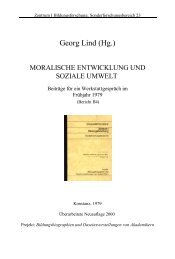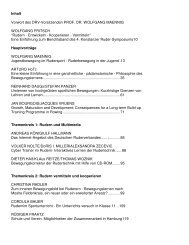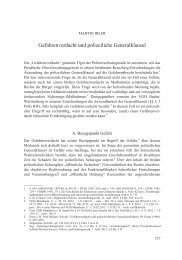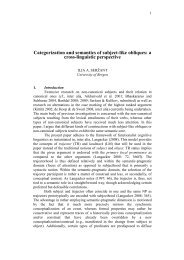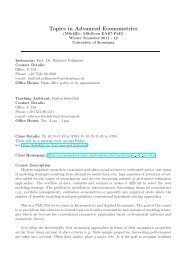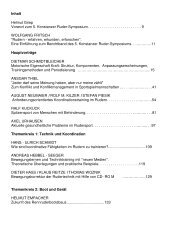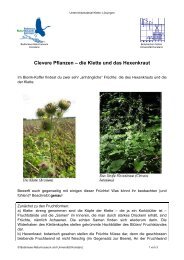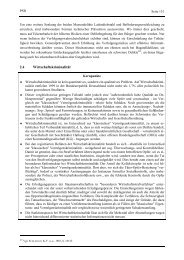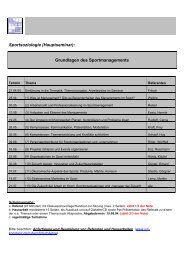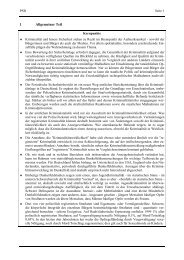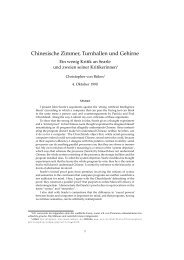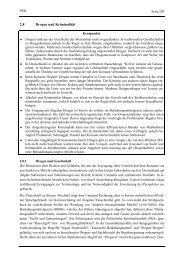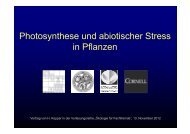Book of Abstracts Book of Abstracts - Universität Konstanz
Book of Abstracts Book of Abstracts - Universität Konstanz
Book of Abstracts Book of Abstracts - Universität Konstanz
You also want an ePaper? Increase the reach of your titles
YUMPU automatically turns print PDFs into web optimized ePapers that Google loves.
A - 12<br />
116<br />
Infrared Spectroscopy <strong>of</strong> CO2 Containing Cluster Anions<br />
Holger Schneider 1 , A. Daniel Boese 2 1, *<br />
, J. Mathias Weber<br />
1 Institut für Physikalische Chemie, <strong>Universität</strong> Karlsruhe, Kaiserstr. 12, 76229 Karlsruhe, Germany<br />
* email: jmathias.weber@chemie.uni-karlsruhe.de<br />
2 Institut für Nanotechnologie, Forschungszentrum Karlsruhe, Pstfach 3640, 76021 Karlsruhe, Germany<br />
Molecular clusters are relevant model systems for the study <strong>of</strong> intermolecular interaction<br />
potentials governing the structures <strong>of</strong> molecular complexes. Structural information on clusters<br />
can be gained from infrared photodissociation spectroscopy in molecular beams [1, 2], and we<br />
have applied this technique to several species, probing the interaction <strong>of</strong> various anions with<br />
CO2. The experimental results are interpreted in the framework <strong>of</strong> density functional theory with<br />
anharmonic calculations <strong>of</strong> vibrational spectra.<br />
Halide-CO2 complexes afford the study <strong>of</strong> the interaction <strong>of</strong> CO2 with closed shell anions <strong>of</strong> low<br />
reactivity [3]. The results are compared with those for Au - ·CO2 [4], which is relevant for the<br />
study <strong>of</strong> catalytic oxidation <strong>of</strong> CO by gold clusters on surfaces [5, 6]. This complex shows<br />
strong interaction between CO2 and the Au - anion, with a strongly deformed CO2 unit.<br />
Complexes <strong>of</strong> O2 - with CO2 show very interesting motifs <strong>of</strong> ion solvation [7]. The π* orbital <strong>of</strong><br />
O2 - <strong>of</strong>fers a template with four a priori equivalent binding sites for the structure <strong>of</strong> the<br />
microsolvation environment. However, only one CO2 ligand is strongly bound, with additional<br />
molecules weakly attached to the resulting CO4 - anion.<br />
The general motif <strong>of</strong> anions binding to CO2 is binding to CO2 via the carbon atom, in contrast to<br />
cations, which generally dock to one <strong>of</strong> the oxygen atoms. The geometry <strong>of</strong> the CO2 molecule is<br />
changed upon complexation with the anion by electrostatic and charge transfer effects. Both<br />
contributions deform the molecule away from the linear configuration <strong>of</strong> neutral CO2 towards<br />
the bent anionic shape.<br />
References<br />
[1] W.H. Robertson and M.A. Johnson, Annu. Rev. Phys. Chem. 54 (2003) 173.<br />
[2] M.A. Duncan, Int. Rev. Phys. Chem. 22 (2003) 407.<br />
[3] J.M. Weber and H. Schneider, J. Chem. Phys. 120 (2004) 10056.<br />
[4] A.D. Boese, H. Schneider, A.N. Gloess, and J.M. Weber, in preparation (2004).<br />
[5] A. Sanchez, et al., J. Phys. Chem. A 103 (1999) 9573.<br />
[6] L.D. Socaciu, et al., J. Am. Chem. Soc. 125 (2003) 10437.<br />
[7] H. Schneider, A.D. Boese, and J.M. Weber, in preparation (2004).



